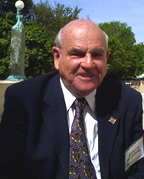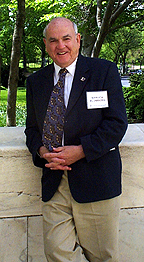| T
H E N I H C A T A L
Y S T |
M A Y
- J U N E 2000 |
|
Nobelist
Baruch Blumberg on a Mission to NIH
ASTROBIOLOGY
AND THE SEARCH FOR ORIGINS
|
by
Fran Pollner |
 Shortly
after Baruch Blumberg came to NIH in 1957, he and others in the clinical research
group he’d joined (in what was then known as the Arthritis and Metabolic
Diseases Institute) started a new section. It was Blumberg who named the new
section "Geographic Medicine and Genetics."
Shortly
after Baruch Blumberg came to NIH in 1957, he and others in the clinical research
group he’d joined (in what was then known as the Arthritis and Metabolic
Diseases Institute) started a new section. It was Blumberg who named the new
section "Geographic Medicine and Genetics."
"Thinking of genes
by themselves can be misleading," he explains. "You can’t look
at just one gene at a time and you can’t look at genes outside the context
of the environment of the host,
both internal and external."
The world at large became
the site of his field work studying polymorphisms and their relation to disease
susceptibility–work that led to the discovery of the Australia antigen
and later, after he’d left NIH, to the identification of the hepatitis
B virus and the development of the hepatitis B vaccine.
Today, Blumberg’s
focus is still, essentially, "geographic medicine and genetics," but
his "geography" has expanded beyond the terrestrial.
Last spring, Blumberg
became the first director of the newly created NASA
Astrobiology Institute (NAI). Its mission is the "study of the origin,
evolution, distribution, and future of life on earth and in the universe."
Headquartered at the Ames Research Center in Mountain View, Calif., its work
is carried out wherever the spirit moves affiliated scientists at what are now
11 participating U.S. institutions and one international team. And, like the
universe, the NAI is expandable.
 |
|
Baruch Blumberg,
director, NASA Astrobiology Institute
|
Blumberg would especially
like to see expansion in the form of coordinated NAI-NIH research. He envisions
a variety of collaborations to be determined between NAI and NIH intramural
scientists—jointly funded projects, perhaps, in such areas as new and emerging
diseases, prebiotic chemistry, and the origins of cancer. He’s had discussions
with acting NIH director Ruth
Kirschstein, deputy director for intramural research Michael
Gottesman, and NIAID director Tony
Fauci, and he plans to talk with more institute heads. Discussions are under
way for an NAI-NIH seminar to acquaint the scientific community here with the
astrobiological plane.
It’s a program of
"discovery, of basic research," Blumberg says. And although much of
the research "is based on the notion that NASA has space flight capabilities,"
most of it to date has actually been conducted on Earth—albeit under the
sea deep within rocks, or embedded in ice, for example. Some of the materials
studied traveled through space to get here.
"Astrobiologists
are very interested in organisms that live under what we think of as extreme
conditions; of course, they are not ‘extreme’ for these organisms,
which we have given the name ‘extremophiles.’"
The greatest probability
for life in our solar system, Blumberg says, is on Mars, Europa (a moon of Jupiter),
and Titan (a moon of Saturn), as well as in "cosmic dust," which can
also be found all over Earth. If life actually exists in these places, it would
most likely be under the conditions of early Earth, before our atmosphere had
oxygen, when extremophiles probably flourished here, he says.
"We want to look
at early Earth and the organisms that are still present in contemporary geothermal
vents," he notes, observing that although such astrobiological explorations
may seem remote, "the whole world of molecular biology, as revealed by
PCR, is based on an enzyme extracted from an extremophile that operates at very
high temperatures"—a discovery that earlier generated considerable
interest in the field of astrobiology.
 |
|
Baruch Blumberg in
town for the National Academy of Sciences annual meeting and to talk about
astrobiology.
|
Some life forms adore
the cold. "A lot of our people are in the Arctic and Antarctic, where they
have found organisms living in ice crystal water channels. Nobody knows if they
cause disease. I’m interested in exploring virology, the phage within these
bacteria under these extreme conditions."
Medical microbiologists
and astrobiologists, Blumberg notes, tend to look at organisms differently.
The "one bug–one disease" paradigm still prevails among the former,
while the latter adopt an "ecological approach," examining, for example,
biofilms, or layers of bacteria glued together with long-chain sugars, and the
interactions among organisms and the relation of their evolution to the changes
in the earth’s environment.
Another possible field
for mutual exploration, presumably with NCI, could revolve around the question,
"When did cancer start?" The answer could be, "When cells first
started," Blumberg speculates. How cells started is a major astrobiological
concern. The search for organic matter in space has uncovered such things as
amino acids in meteorites and organic molecules floating freely in space dust.
"There’s a lot going on in prebiotic chemistry," Blumberg says,
including teasing out when prebiotic becomes biotic.
The NAI’s initial
request for proposals from institutional groups representing multiple disciplines
brought in 50-plus applications, 11 of which were accepted. In addition to the
Ames Research Center, the other lead institutions are Arizona State University,
Tempe; the Carnegie Institution of Washington (D.C.); Harvard University, Cambridge,
Mass.; the Jet Propulsion Laboratory, Pasadena, Calif.; the Johnson Space Center,
Houston; the Marine Biology Laboratory, Woods Hole, Mass.; Pennsylvania State
University, University Park, Pa.; the Scripps Research Institute, La Jolla,
Calif.; the University of California at Los Angeles; and the University of Colorado,
Boulder.
Blumberg is currently
also senior advisor to the president of the Fox Chase Cancer Center in Philadelphia,
where he was formerly vice president for population oncology and associate director
for clinical research—and the recipient for 30 years of an NIH grant for
a liver cancer prevention program.

Return to Table of Contents
 Shortly
after Baruch Blumberg came to NIH in 1957, he and others in the clinical research
group he’d joined (in what was then known as the Arthritis and Metabolic
Diseases Institute) started a new section. It was Blumberg who named the new
section "Geographic Medicine and Genetics."
Shortly
after Baruch Blumberg came to NIH in 1957, he and others in the clinical research
group he’d joined (in what was then known as the Arthritis and Metabolic
Diseases Institute) started a new section. It was Blumberg who named the new
section "Geographic Medicine and Genetics."
